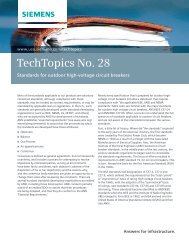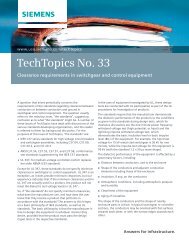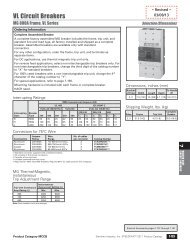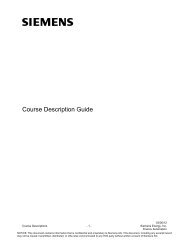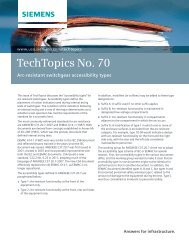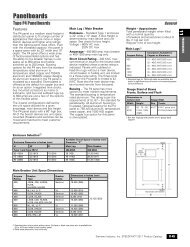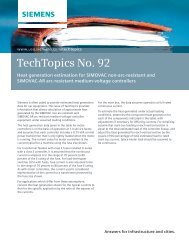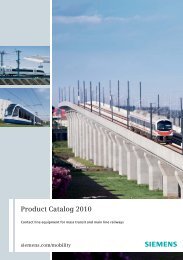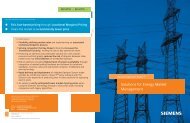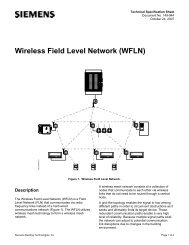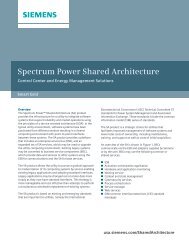Cover/Back.preflight (Page 2) - Siemens
Cover/Back.preflight (Page 2) - Siemens
Cover/Back.preflight (Page 2) - Siemens
Create successful ePaper yourself
Turn your PDF publications into a flip-book with our unique Google optimized e-Paper software.
Primary Rating<br />
The input, source, or supply side<br />
connected to the primary of the<br />
transformer in a circuit.<br />
Rating<br />
The design characteristics, such<br />
as primary and secondary voltage,<br />
KVA, capacity, temperature rise,<br />
frequency, etc.<br />
Ratio<br />
Refers to the turns ratio or the voltage<br />
ratio between the primary and secondary<br />
winding.<br />
Reactance<br />
The effect of inductive and capacitive<br />
components of a AC circuit producing<br />
other than unity power factor.<br />
Reactor<br />
A single winding device with an air or<br />
iron core which produces a specific<br />
amount of inductive reactance into a<br />
circuit, usually to reduce or control<br />
current.<br />
Reduced Capacity Taps<br />
Taps which are rated for winding<br />
current only (versus rated KVA), thus<br />
reducing available power because of<br />
lower output voltage.<br />
Regulation<br />
The percent change in secondary output<br />
voltage when the load changes from full<br />
load to no-load at a given power factor.<br />
Scott Connection<br />
A transformer connection generally<br />
used to get a two phase output from<br />
the secondary of a three phase input,<br />
or vice versa.<br />
Sealed Transformer<br />
An enclosed transformer completely<br />
sealed from the outside environment<br />
and usually contains pressurized<br />
inert gas.<br />
Secondary Rating<br />
The output, or load side connected<br />
to the secondary of the transformer<br />
in a circuit.<br />
Series/Multiple<br />
A winding consisting of two or more<br />
sections which can be connected for<br />
series operation or multiple (parallel)<br />
operation. Also referred to as dual<br />
voltage or series-parallel.<br />
Star Connection<br />
Same as wye connection.<br />
Step-down Transformer<br />
One in which the energy transfer is<br />
from the high voltage winding (primary<br />
input circuit) to the low voltage winding<br />
(secondary output or load circuit).<br />
Step-up Transformer<br />
The energy transfer is from the low<br />
voltage winding to the high voltage<br />
winding; with the low voltage winding<br />
connected to the power source (primary<br />
input circuit) and the high voltage<br />
connected to the load (secondary output<br />
circuit).<br />
T-connection<br />
Use of Scott connection for three phase<br />
operation using two primary (main) and<br />
two secondary (teaser) coils.<br />
Tap<br />
A connection brought out of winding<br />
at some point between its extremities<br />
to permit changing the nominal voltage<br />
ratio. Taps are usually located in the<br />
high voltage winding, typically expressed<br />
as FCAN and FCBN for no-load<br />
operation.<br />
Temperature Rise<br />
The increase over ambient temperature<br />
of the winding due to energizing and<br />
loading the transformer; typically<br />
measured as either average rise by<br />
resistance or as hot-spot.<br />
Terminal Chamber<br />
An enclosure with space for making<br />
connection to a substation transformer,<br />
typically used when the transformer is<br />
not direct connected or close coupled to<br />
another device.<br />
Total Losses<br />
The transformer electrical losses which<br />
include no-load losses (core loss) and<br />
load losses (winding losses).<br />
Turns Ratio<br />
See Ratio.<br />
Transformer<br />
A static electrical device which by<br />
electromagnetic induction transforms<br />
energy at one voltage or current to<br />
another at the same frequency.<br />
Transformer Tests<br />
Normal, routing production tests<br />
include: (1) core loss (excitation loss<br />
or non-load loss); (2) load loss –<br />
winding or copper loss; (3) Impedance;<br />
(4) Hi-pot – high voltage between<br />
windings and ground; (5) Induced –<br />
double induced two time normal<br />
voltage. Optional special tests include:<br />
(a) Heat Run – temperature testing;<br />
(b) Noise tests – sound level measurement<br />
(c) Impulse tests – BIL tests.<br />
Transverse Mode<br />
Electrical noise or voltage disturbance<br />
that occurs between phase and neutral,<br />
or from spurious signals across the<br />
metallic hot line and the neutral<br />
conductor.<br />
UL<br />
Underwriters Laboratories.<br />
Voltage Ratio<br />
See Ratio.<br />
Voltage Regulation<br />
The change in secondary voltage which<br />
occurs when the load is reduced from<br />
rated value to zero, with the values of<br />
all other qualities remaining unchanged.<br />
Regulation may be expressed in percent<br />
(per unit) on the basis or rated<br />
secondary voltage at full load.<br />
Winding Losses<br />
See Load Losses.<br />
Wye Connection<br />
A three phase connection with similar<br />
ends of each phase connected together<br />
at a common point which forms the<br />
electrical neutral point which is typically<br />
grounded.<br />
Zig-Zag<br />
Special transformer connection<br />
commonly used with grounding<br />
transformers. See also grounding<br />
transformers.<br />
29




